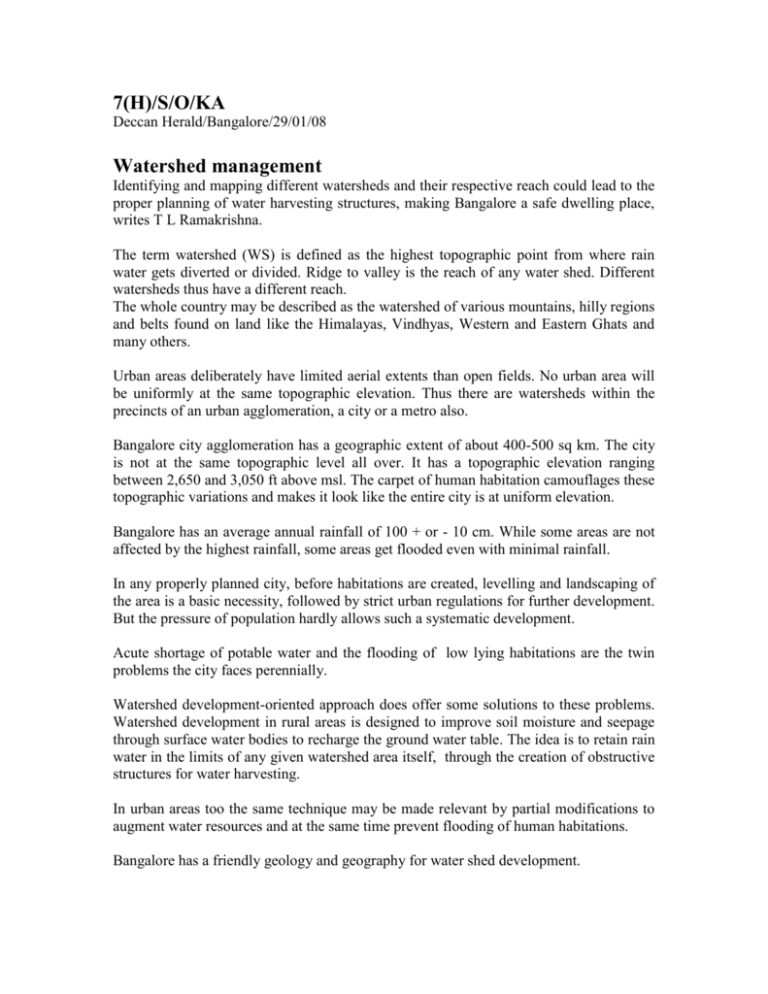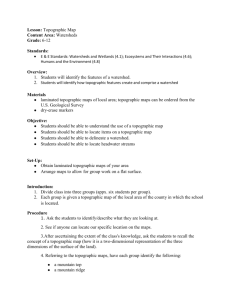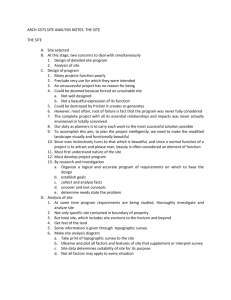Watershed management - India Environment Portal
advertisement

7(H)/S/O/KA Deccan Herald/Bangalore/29/01/08 Watershed management Identifying and mapping different watersheds and their respective reach could lead to the proper planning of water harvesting structures, making Bangalore a safe dwelling place, writes T L Ramakrishna. The term watershed (WS) is defined as the highest topographic point from where rain water gets diverted or divided. Ridge to valley is the reach of any water shed. Different watersheds thus have a different reach. The whole country may be described as the watershed of various mountains, hilly regions and belts found on land like the Himalayas, Vindhyas, Western and Eastern Ghats and many others. Urban areas deliberately have limited aerial extents than open fields. No urban area will be uniformly at the same topographic elevation. Thus there are watersheds within the precincts of an urban agglomeration, a city or a metro also. Bangalore city agglomeration has a geographic extent of about 400-500 sq km. The city is not at the same topographic level all over. It has a topographic elevation ranging between 2,650 and 3,050 ft above msl. The carpet of human habitation camouflages these topographic variations and makes it look like the entire city is at uniform elevation. Bangalore has an average annual rainfall of 100 + or - 10 cm. While some areas are not affected by the highest rainfall, some areas get flooded even with minimal rainfall. In any properly planned city, before habitations are created, levelling and landscaping of the area is a basic necessity, followed by strict urban regulations for further development. But the pressure of population hardly allows such a systematic development. Acute shortage of potable water and the flooding of low lying habitations are the twin problems the city faces perennially. Watershed development-oriented approach does offer some solutions to these problems. Watershed development in rural areas is designed to improve soil moisture and seepage through surface water bodies to recharge the ground water table. The idea is to retain rain water in the limits of any given watershed area itself, through the creation of obstructive structures for water harvesting. In urban areas too the same technique may be made relevant by partial modifications to augment water resources and at the same time prevent flooding of human habitations. Bangalore has a friendly geology and geography for water shed development. Important minor water sheds within Bangalore city are High Grounds, Madhavnagar, Bugle Rock, Mount Joy, Palace Guttahalli, Gavipuram, Basavangudi, plateaus of Jayanagar, J P Nagar, Rajajinagar, western parts of Malleswaram, Sadashivnagar, etc. Correspondingly, there are topographic lows or valleys, troughs like swimming pool, pipe line areas of Malleswaram, Srirampuram, Okalipuram, Seshadripuram, Chamarajpet, Cottonpet, Puttenahalli, Ejipura, etc. There were several tanks in the area which have since been encroached. The still surviving vestige tanks are the Sankey tank, Sampangi tank, Ulsoor lake, Yediyur lake, Gavipuram lake, etc. It is these areas that are targets of flooding. The contiguous locality planning without any intervening break, topographic or green belt, does offer some benefits. But, if the city had been developed sector wise with intervening topographic breaks for tanks or mini forests or green belts, the pressure of the burgeoning or swelling population could have been less felt. This could have aided better development and the maintenance of law and order. Identifying and mapping different watersheds and their respective command or reach areas could lead to the planning of proper watershed development or water harvesting structures. This could help in satisfactorily identifying the areas most likely to be flooded and the erection of water harvesting structures at suitable points. The most relevant WS structures could be contour bunds or trenches, check dams, loose boulder dikes, hidden dikes, etc. which would in addition control flooding, soil erosion and silting of tanks also. The water storing structures could include percolation tanks, dug in ponds, etc. Such a development would ultimately result in rain water getting arrested in plateaus or highlands, which would percolate down to charge the ground water, and the flooding of low lying area could be minimised, if not prevented. There is a world of difference between what Bangalore should have been and what it is. Watershed model offers safer dwellings, atleast in future.







